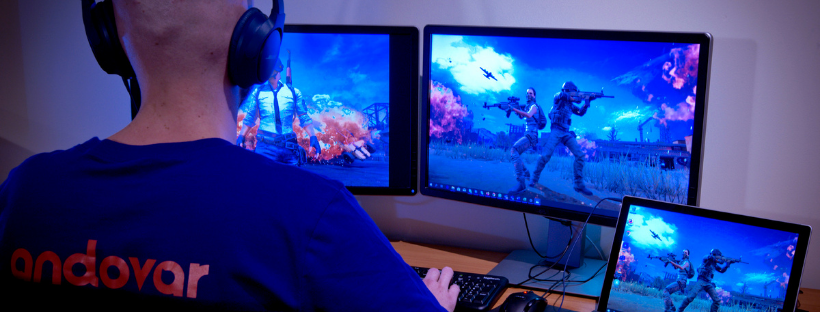Part 2: Localization
The bulk of game localization involves translating, culturalizing and internationalizing, as well as delivering a whole range of digital in-game and game marketing assets. It also includes continuous localization, which takes the form of updating assets and providing ongoing user support, among other work following the completion of the initial localization project. Types of content that are localized typically include in-game content translation, text that appears in graphics, subtitles, transcreation, dialogues, voiceover work, marketing content and content translation QA tests.
The earliest engagement of localization experts in the timeline of a game's development may start as early as the initial development phase of the game's characters, storyline and technical aspects. In other words, the localization process can really begin at anytime, whether during or following the development of your game.
Game developers can expect to work with localization teams that include localization project managers, linguists, voiceover dubbing specialists, engineers, technicians, production managers, production assistants, legal specialists, in-country reviewers, marketing localization specialists and other professionals. It takes a collaborative team of experts in these and other disciplines to produce top-quality video game localization.
Some larger game development companies do most of their own localization work themselves. Others frequently outsource as much as half of the translation work and other parts of the process to experts who specialize in a variety of different areas during the localization process. In some cases, game developers may rely on external resources to meet short timelines or to manage lengthy projects that require expert localization vendors. In comparison, smaller game developers typically hand off the entire localization phase of their game's creation process to localization service providers (LSPs) and preserve their in-house resources for refining their game design.
Table of Contents
1. Having your new game localized
2. Assets to be localized in a video game
3. Collaborating with localization experts to ensure quality outcomes
4. Translation
5. Culturalization
6. Internationalization
7. Game localization process
8. Preliminary examination of source files
9. In-country reviewing
10. Game localization testing
11. Quality assurance
12. Adjacent services
13. Continuous localization
14. Game localization technologies
15. Achieving accurate and high-quality game localization
16. Takeaway

1. Having your new game localized
Of course, the point of localizing a game is to provide everyone who plays it with a level of engagement that matches the vision of the game's creator and should accurately convey the quality and experiences that players would receive if they were playing the game in its native tongue. The dialogue, characters and graphical elements all need to be presented exactly as intended to resonate with players.
In order to accomplish high-quality localization, the LSP professionals you're working with must be reliable in capturing the nuances of regional and local dialects. They also need to possess a deep understanding of national, regional and local cultures, as well as the whole array of references they encompass. Having a strong grasp of slang terms and usages, and accompanying affectations popular in the local culture, are all exceptionally useful skills that will aid localizers in delivering the most effective translations.
It goes without saying that there are many other subtleties of communication that must be captured for a game to be ideally localized in any market targeted for distribution. That being said, many game designers new to localization aren't entirely sure what achieving that level of accuracy involves.

2. Assets to be localized in a video game
Game localization typically includes treatment of these in-game content types:
- Text — User Interface, subtitles, captions and in-game text files.
- Visuals — Graphics and other visual digital artwork.
- Audio — Audio files to be dubbed with voice-overs.
Localization can often further include:
- Product packaging — Physical packaging labels and other text for print, digital files with instruction manuals, user guides, policies, and various other print and digital materials.
- Marketing materials and ads — Game product marketing and advertising materials for both print and digital formats.
- Social pages — Instructive and player-engagement content for social media posting.
- Website — Landing and internal pages of dedicated game websites, including instructions, information, directions, text in graphics, policies, updates, surveys, contact and others.

3. Collaborating with localization experts to ensure quality outcomes
The localization team researches and provides guidance to game developers on any and all potential issues involving linguistics or expectations of quality. Many issues are avoidable by applying best practices and meticulous attention to essentials, such as resourcing strings in files, testing fonts for languages, coding choice, scaling text size, wrapping text, addressing gender, grammar concerns and other fundamentals.
In Part 8, we will discuss localization challenges in further detail, explaining how to ensure quality through collaboration in order to prevent typical errors that can impact the overall quality of your game's localization.

4. Translation
Localization work involves translating text strings from repositories and audio files. Quality translations accurately interpret the words in a game's dialogue and text elements, including text within graphics. It also ensures the proper usage of words and phrases as they are applied in the context of the target language, country or region. Further, translated game content must sound natural in the gamer's environment. It must be relatable to his or her cultural experience.
Translators and reviewers need to be allotted enough time to acclimate to regional guidelines and glossaries. Ideally, guidelines should be accompanied by sample translations in the translator's own native language, as well as in the language targeted for translation.
Further, translators should be exposed to the game while it is in play in order to help them more fully appreciate the characters' experiences and the creator's vision. In some cases, developers can provide translators with web apps too so that they can experience the UI text elements more thoroughly.
Finally, there is debate in the industry about the potential benefits of providing translators with access to the developer's staging server, allowing them to understand the content in context. If you are considering this option, please discuss its benefits with your chosen games localization company first.

5. Culturalization
Culturalization is the part of the localization process in which attention is focused on the translation in order to make dialogue and text as genuine and natural sounding as possible in every country, region and local area. Culturalization is necessary to make the game relatable for all users, which is a key quality goal that largely makes the difference between a quality game and a seemingly unnatural, poorly produced game. Part 4 on culturalization will go over this topic in closer detail.

6. Internationalization
Internationalization is the process that prepares a video game for the localization process that will follow. Internationalizing involves a set of steps to eliminate any pieces of code that vary from one language and dialect in a particular international market to another. Internationalization enables the game's architecture and code to become more adaptable and streamlines translation efforts, helping localizers to create dialogue and text that can more easily communicate with gamers in different languages and cultures. Part 5 will focus further on this topic.

7. Game localization process
Here's a general overview of the series of elements in typical localization processing (please note that services vary between LSPs). The localization process begins with mapping out the workflow, starting with such operational basics as deciding who will be in the hierarchy on the project, determining which computer aided translation (CAT) environment should be used, how support needs to function, how testing will be conducted and a myriad of other facets of localization project planning.

8. Preliminary examination of source files
To ensure user satisfaction for the game, source files should be examined to check that the quality of the content is sufficient for translating. This should be done before releasing the files to your games localization company. Ideal translation can't compensate for serious issues of poor-quality source text. Those deficiencies will carry along with the translated dialogues and text, potentially weakening the value of the game product, its marketability, and even the game developer and publisher's brands.

9. In-country reviewing
In-country reviewers, who are reviewers inside the countries where the localized game will be distributed, are the last line of defense for game developers and LSPs who need to ensure that their localization work is accurate prior to launching in a target market. For quality of current and future localization projects, make it a high priority to have glossaries and style guidelines approved by these reviewers prior to production.

10. Game localization testing
All forms of game localization testing are essential to the overall quality of experience when playing the game. QA testing for video games may include testing interfaces, audio, play functionality and experience, text in graphics, supplementary narratives, cutscenes, culturalization, and other aspects of the game's presentation. Create a thorough plan to make the most of this testing period. Part 9 of this guide will discuss quality assurance during localized game testing in more detail.

11. Quality assurance
After localization is complete, having an outside party sample test the translation and apply the spectrum of QA evaluations is standard practice. If budget or time constraints do not allow contracting a third party for a complete QA evaluation, you should at least conduct an abridged QA testing process in-house prior to importing content into a game's architecture following localization. Part 6 on localization technologies will highlight some helpful software tools for QA testing.

12. Adjacent services
Developer support, functional testing of games and various other peripheral services are often provided by localization service providers for game designers. Sometimes developers opt to bring in localization experts to fill such roles during early product development phases.

13. Continuous localization
There's always more to do after localization. Continuous localization can mean providing tech support or other user helpdesk services in various languages. Continuous game localization also includes any ongoing series of applications of localization efforts, such as applying software patches and various solutions for user issues, announcements, rolling out expansion packs and downloadable content, supplements, content for downloads, etc.

14. Game localization technologies
Numerous technologies are available to improve translation accuracy and reduce costs, as well as to speed up translation and testing processes, project management tasks, and other critical processes in localization systems. Part 6 on localization technologies will include a discussion on the application of current and upcoming technologies.

15. Achieving accurate and high-quality game localization
Start by reviewing some games produced by other companies and localized for your own native language and dialect. Use your judgment of their quality as a baseline to establish your expectations and evaluate the quality of your own localization outcomes.
Then, apply these important tips for more productive collaboration with your localization team and, ultimately, the greater quality and accuracy of your game localization project outcome:
- Ensure clear communications — Make sure translators understand your expectations for dialogues, characters and text in graphics so that their output aligns with your vision. Game designers, translators, localization project managers, production team members, reviewers and everyone else on the project should be encouraged to communicate freely.
- Allow everyone reasonable timeframes — To get the best possible results from localization processes requires the provision of practical timeframes for work to be done. As most people working in video games are aware of, crunch periods almost never pay off for a game's overall quality. A key requirement for high-quality localization is to therefore allow translators, in-country reviewers, editors and other localization team members sufficient opportunity to examine materials before initiating the production process.
- Assign someone to work with the LSP project manager — Assign someone to communicate with your games localization company on routine operational matters, daily decisions and modifications. In addition, they should facilitate the receipt of deliverables and help handle matters as needed to ensure accuracy, quality, time-frames and other areas .

16. Takeaway
Create a comprehensive localization project checklist, and make sure every item on it gets done at the right time. Get as many tasks as possible done as early as possible. See Part 1 of this guide on pre-production for details on what to do prior to starting your game's translation and the remaining phases of the localization process. When in doubt, adhere to the IGDA Best Practices for Game Localization and refer to Part 8 of this guide to learn about the various common mistakes to avoid. Finally, encourage collaboration and creative problem solving to promote the optimal quality of your localization project outcomes.
So with that we have summarized what goes into the overall localization process for video games. Part 3 of this comprehensive mini-guide will dive deeper into translations, detailing who exactly should be translating your games, what assets will be translated and what you need to prepare, as well as some general tips and tricks to ensure your translation quality. We look forward to seeing you there.

For more tips and content for global growth, please visit our blog.











